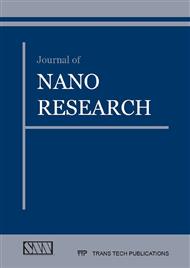[1]
D. Seifu, A. Kebede, F.W. Oliver, E. Hoffman, E. Hammond, C. Wynter, A. Aning, L. Takacs, I.L. Siu, J.C. Walker, G. Tessema, M.S. Seehra, Evidence of ferrimagnetic ordering in FeMnO3 produced by mechanical alloying, J. Magn. Magn. Mater. 212 (2000).
DOI: 10.1016/s0304-8853(99)00787-8
Google Scholar
[2]
P.A. Montano, Technological applications of mössbauer spectroscopy, Hyperfine Interactions, 27 (1986) 147-159.
DOI: 10.1007/bf02354751
Google Scholar
[3]
I.R. Leith, M.G. Howden, Temperature-programmed reduction of mixed iron-manganese oxide catalysts in hydrogen and carbon monoxide, Appl. Catal. 37 (1988) 75-92.
DOI: 10.1016/s0166-9834(00)80752-6
Google Scholar
[4]
K. Ehrensberger, A. Frei, P. Kuhn, H.R. Oswald, P. Hug, Comparative experimental investigations of the water-splitting reaction with iron oxide Fe1−yO and iron manganese oxides (Fe1−xMnx)1−yO, Solid State Ionics, 78 (1995) 151-160.
DOI: 10.1016/0167-2738(95)00019-3
Google Scholar
[5]
H. Le Roux, A Mossbauer study of paramagnetic and magnetic components in an uncalcined iron manganese oxide powder, J. Phys.: Condens. Matter 2 (1990) 3391.
DOI: 10.1088/0953-8984/2/14/023
Google Scholar
[6]
C.A. Goodwin, H.K. Bowen, W.D. Kingery, Phase Separation in the System (Fe, Mn)O, J. Amer. Ceram. Soc. 58 (1975) 317-320.
Google Scholar
[7]
P. Franke, R. Dieckmann. Defect structure and transport properties of mixed iron-manganese oxides, Solid State Ionics, 32/33 (1989) 817-823.
DOI: 10.1016/0167-2738(89)90363-9
Google Scholar
[8]
B. Kolk, A. Albers, G.R. Hearue, H. Le Roux. Evidence of a new structural phase of manganese-iron oxide, Hyperfine Interactions, 42 (1988) 1051-1054.
DOI: 10.1007/bf02395571
Google Scholar
[9]
H. Hayashi , M. Watanabe, H. Inaba, Measurement of thermal expansion coefficient of LaCrO3, Thermochim Acta, 359 (2000) 77-85.
DOI: 10.1016/s0040-6031(00)00507-4
Google Scholar
[10]
O. García-Moreno, A. Borrell, B. Bittmann, A. Fernández, R. Torrecillas, Alumina reinforced eucryptite ceramics: very low thermal expansion material with improved mechanical properties, J. Eur. Ceram. Soc. 31 (2011) 1641-1648.
DOI: 10.1016/j.jeurceramsoc.2011.03.033
Google Scholar
[11]
I.D. Lick, D.B. Soria, Synthesis of MnFeO3 from the oxidative thermal decomposition of Mn[Fe(CN)5NO]·2H2O, J. Arge. Chem. Soc. 97 (2009) 102-108.
Google Scholar
[12]
H. L. Roux, A mössbauer study of paramagnetic and magnetic components in an uncalcined iron manganese oxide powder, J. Phys.: Condens. Matter 2 (1990) 3391-3398.
DOI: 10.1088/0953-8984/2/14/023
Google Scholar
[13]
S.B. He, S.F. Wang, Q. P. Ding, X. D. Yuan, W.G. Zheng, X. Xiang, Z. J. Li, X. T. Zu, Role of chelating agent in chemical and fluorescent properties of SnO2 nanoparticles, Chin. Phys. B 22 (2013) 058102-1-4.
DOI: 10.1088/1674-1056/22/5/058102
Google Scholar
[14]
S. F. Wang, X. Xiang, G.A. Sun, X.L. Gao, B. Chen, Q.P. Ding, Z.J. Li, C.F. Zhang, X.T. Zu, Role of pH, organic additive, and chelating agent in gel synthesis and fluorescent properties of porous monolithic alumina, J. Phys. Chem. C 117 (2013).
DOI: 10.1021/jp311055b
Google Scholar
[15]
M.F. Zhang, J.M. Liu, Z.G. Liu, Microstructural characterization of nanosized YMnO3 powders: the size effect, Appl. Phys. A 79 (2004) 1753–1756.
DOI: 10.1007/s00339-004-2901-x
Google Scholar
[16]
S. F. Wang, G. Z. Sun, L. M. Fang, L. Lei, X. Xiang, X. T. Zu, A comparative study of ZnAl2O4 nanoparticles synthesized from different aluminum salts for use as fluorescence materials, Sci. Rep-UK 5 (2015) 12849.
DOI: 10.1038/srep12849
Google Scholar
[17]
W.C. Wang, S. Li, Y.Y. Wen, M.C. Gong, L. Zhang, Y.L. Yao, Y.Q. Chen, Synthesis and characterization of TiO2/YFeO3 and its photocatalytic oxidation of gaseous benzene, Acta Phys. -Chim. Sin. 24 (2008) 1761-1766.
DOI: 10.1016/s1872-1508(08)60072-8
Google Scholar
[18]
Y. Zhang, H. Liang, C. Y. Zhao, Yuan Liu, Macroporous alumina monoliths prepared by filling polymer foams with alumina hydrosols, J Mater Sci (2009) 44: 931–938.
DOI: 10.1007/s10853-008-3189-6
Google Scholar
[19]
T. Xian, H. Yang, X. Shen, J. L. Jiang, Z. Q. Wei, W. J. Feng, Preparation of high-quality BiFeO3 nanopowders via a polyacrylamide gel route, J. Alloy. Comp. 480 (2009) 889-892.
DOI: 10.1016/j.jallcom.2009.02.068
Google Scholar
[20]
S.Q. Wu, Y.Y. Liu, L.N. He, F.P. Wang, Preparation of β-spodumene-based glass–ceramic powders by polyacrylamide gel process, Mater. Lett. 58 (2004) 2772-2775.
DOI: 10.1016/j.matlet.2004.04.017
Google Scholar


